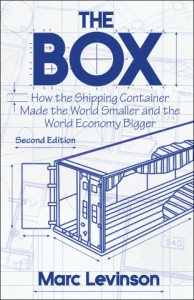
On April 26, 1956, a crane lifted fifty-eight aluminum truck bodies aboard a refitted oil tanker in Newark, New Jersey. Five days later, the Ideal-X sailed into Houston, where fifty-eight trucks waited to haul the metal boxes to their destinations. This was the beginning of a revolution that made the global trade boom possible.
Before the container revolution, the high cost of moving goods was a major impediment to international trade. The container, a simple and entirely soulless steel box held together with welds and rivets, changed that, driving down transportation costs and in the process reshaping economic geography. The Box: How the Shipping Container Made the World Smaller and the World Economy Bigger, tells the dramatic story of the container’s creation, the decade of struggle before it was widely adopted, and the seismic shifts it helped bring about — shifts with far-reaching consequences for workers, communities, and the international economy.
The Box is essential reading for anyone seeking to understand globalization, the rise of modern logistics, and the origin of international supply chains. Published on the fiftieth anniversary of the first containership voyage, It was shortlisted for the Financial Times/Goldman Sachs Business Book of the Year award and was honored with a number of other awards and prizes. It was selected as one of the best business books of 2006 by Business Week, the Financial Times, and the Globe and Mail, and was cited as one of the best business books ever in the New York Times. Bill Gates named it the best book he read in 2013. It has been translated into many languages. The second edition updates the story, explaining why the megaships that came into use after 2010 threw the shipping industry into turmoil and made companies’ supply chains less reliable than they had been a decade earlier.